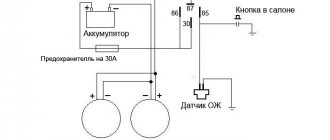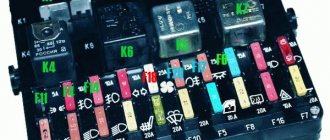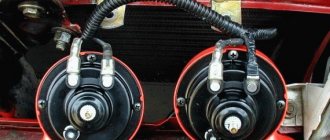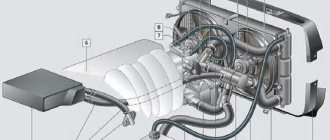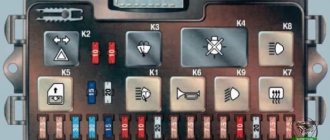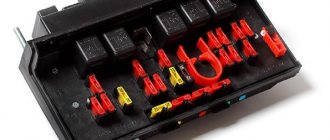The radiator cooling fan does not work (does not turn on) - reasons, troubleshooting
– blown, check the fuse that controls the fan
– the fan switch sensor (FVS) is faulty
– fan relay is faulty
– faulty fuse box
– power cable break
– break in the output path to the radiator sensor wire
– the gasket under the head is burned out (coolant does not pass into the cylinder)
Problems with the cooling fan usually occur in used cars with decent mileage. This breakdown manifests itself in different ways; the fan may not work stably, may turn on late or not turn on at all.
There can be quite a few reasons why the fan does not turn on, from a banal fuse blown to more complex problems associated with a malfunction of the thermostat or problems with the electrical wiring of the vehicle's on-board network.
If the engine boils, but the fan still does not turn on, then the first thing that comes to mind for most motorists is problems with the fan wiring. However, very often the wiring has nothing to do with it, and the real reason lies precisely in the thermostat. The device designed to monitor the temperature of the coolant (coolant) may fail or simply jam, after which the coolant stops circulating through the radiator, as a result, the radiator sensor does not work, and the fan itself does not turn on.
Then check the fuse that controls the fan; if the fuse is blown, replace it with a intact one. If the cause is not a fuse, you need to check the fan itself directly. The power wires come to it; often they simply crumble or break off due to age. Alternatively, the reason may lie in the plug, so if everything is fine with the wiring, turn off the power to the fan and check the plug for a malfunction. Connect power to the fan directly, for example, from the battery; if the fan does not react in any way, we conclude that the fan is faulty.
Check the fan switch sensor (FSW) located on the radiator. To do this, you need to disconnect the plugs and then connect them together; if the fan does not work, the DVV is faulty and requires replacement.
It is necessary to connect the wire going to the fuse box directly to ground (usually white with a black stripe). If after this the fan starts working, we can conclude that the second black wire has broken; try to find the break and check whether its connection to ground is reliable. After that, we connect the two wires together and see what happens, if the fan turns on, then the problem was a bad connection.
Check the fan relay, it is quite possible that the problem is there. In order to find out, simply replace it with an adjacent relay, then connect the radiator sensor wires to each other, see above. The fan will turn on - the problem is a faulty relay.
Next, you need to check the voltage to see if it is supplied to the fan through the fuse box. To do this, take a piece of wire and install it in the relay connectors; if the fan is working, the reason why the fan does not work is in the fuse box.
It is likely that voltage is not being supplied to the fan relay. To check this, you can use the “old-fashioned” method. We take a light bulb that will serve as a “control”. If there is no light bulb, just lightly strike the other end of the wire against ground, if you see a spark, there should be no problems, most likely this is not the reason. If you don’t see a spark, most likely there is no voltage in this connector, that is, there is a break in the track in the fuse block.
If, after checking all of the above, you find the reason why the radiator fan does not turn on, you only have to check one wire - the radiator sensor wire. To do this, you must remove the switch as it does not allow access to the fuse box plugs. This means we remove the plug from the fuse block and check the radiator sensor wire for a break.
We check as follows: connect the wire to the “+” terminal of the battery, install the other end into the connector of the chip. Next, remove the plug from the sensor and connect the light bulb. If there is no light bulb, make a “teal” to ground. If there is no voltage, most likely this wire is broken.
If the fan does not turn on, the reason may be completely unexpected, for example, a burnt gasket under the head. Switching on does not occur for the reason that the coolant does not enter the cylinder, while gases from the cylinder penetrate into the coolant, creating an effect known as an air lock. This plug prevents normal coolant pumping. How to understand that you have a burnout? It is enough to look into the expansion tank, if bubbles come out of it every now and then during operation - you have a burnt gasket, or there is a crack in the cylinder.
WHAT TO DO IF THE RADIATOR COOLING FAN DOES NOT WORK
Making sure that the radiator cooling fan has failed and is not working is quite simple. To do this, you need to start the car engine and let it idle for some time. When the dashboard shows that the coolant temperature is approaching the critical zone, the sensor will notify the radiator fan so that it starts working. At this moment, the driver will hear additional noise from under the hood, and when he opens it, he will see that the fan impeller is spinning near the radiator. If the coolant temperature has reached a critical value, and the radiator cooling fan does not turn on, you need to find out why this is happening. The following are the main reasons why the radiator cooling fan does not work:
Problems with the electric motor. If the electric motor fails, its rotor will not spin, and accordingly, the impeller will not rotate. You can check the performance of the electric motor by connecting it directly to the battery. To do this, you will need to take two wires, connect them to two battery terminals and two electric motor terminals. If the fan does not spin when connected directly to the battery, we can conclude that the electric motor needs to be replaced; Problems with the sensor. If the sensor is unable to detect the coolant temperature and transmit a signal to turn on the electric motor, it will need to be replaced. To make sure that it is not working, you need to disconnect two wires from it and short them together. If the electric motor starts to spin the impeller, this will indicate that the sensor is faulty and needs to be replaced; There is no tension. The third and most common reason for a non-working radiator cooling fan is the lack of voltage in its power supply circuit. If there is a break in the wires or a fuse fails, the circuit will be de-energized. To make sure that this problem exists, you need to “ring” the wires and check the fuses. If the radiator cooling fan does not turn on, it is quite easy to find the cause of the problem; just perform the checks described above.
Design and principle of operation
The designers of the Chevrolet Niva used a dual fan unit in the cooling system. This slightly complicated the connection diagram, but sharply increased the efficiency of radiator airflow. The fans are driven by 12-volt DC synchronous motors with a permanent magnet inductor. Electric motors have a closed, non-demountable design and do not require maintenance.
The power of each electric motor is 110 W. The fan assembly draws 18 amps.
The fans are turned on one by one using an electromagnetic relay controlled by the on-board computer. When the coolant heats up above 99 degrees, the electric fan located closer to the engine air intake starts. The switch-on temperature of the second impeller is 101 degrees. The fan connection diagram is shown below.
Electrical circuit of Niva Chevrolet fans
The fan power system includes three relays and a resistor, which, if necessary, provides a reduced rotation speed of the first motor. Power is supplied from the battery through fuses that save the wiring and battery in the event of a short circuit. Control signals come from pins 29 and 68 of the motor controller.
The fans automatically turn off when the antifreeze cools to 95 degrees.
Consecutive switching on and off of engines reduces the load on the on-board electrical network. In most cases, it is possible to normalize the temperature only with the help of the first fan. This is especially useful when driving at night, when headlights and side lights put a lot of stress on the generator.
The ability to force fans on can be useful when driving off-road or in city traffic jams. However, the designers of the Chevrolet Niva did not provide the car with this function. It can be implemented independently or at a service station. It is necessary to connect backup relays parallel to the switching contacts and power them from a button installed in the car interior.
Useful video about installing and connecting the forced fan button on the Shnivy:
Important: forced activation increases the reliability of the cooling system. In case of malfunctions of sensors, relays or on-board computer, the driver can manually turn on the radiator airflow.
It is useful to equip the Chevrolet Niva with a switch that forcibly turns off the fan motors. This will protect their blades when fording water obstacles.
Wind blower
Wind blower
More speed means better cooling, but this is only partly true. As acceleration proceeds, all other things being equal, the engine power and the amount of heat “dumped” into the cooling system grow almost by the cube of the speed, and the wind pressure only by the square. It happens that at the optimal 90–100 km/h there is enough cooling even with a dirty radiator, and at maximum speed the electric fan does not turn off. One step away from overheating - it’s better to let off the gas. Of course, there are heavier driving modes - also associated with the release of high power, but at low speeds, when the oncoming flow is weak or absent (with a tailwind). Driving in first gear in deep sand, on a steep climb of a mountain road, or towing another car through the mud, you cannot do without forced airflow of the radiator! His refusal is like a death sentence for the engine.
There are two types of fan drives - mechanical (usually V-belt drive) and electric. In the first, the speed of the impeller and the engine are strictly connected. At low speeds and heavy loads this is dangerous: the airflow is weak. In other modes, the fan, constantly rotating, unnecessarily consumes engine power and fuel, and after starting in cold weather, it slows down the warming up of the engine. The drive with a viscous coupling is more “conscious” - it monitors the temperature of the coolant in the radiator. UAZ-Patriot received such a system.
An electric fan is more economical: it works only when necessary, and its power is several times less than the power of a mechanical fan cranked up to maximum speed. But at low engine speeds and high loads, a mechanical “wind blower” is inferior to an electric one; the latter is more efficient. At high loads and engine speeds, an electric fan is usually inferior to a mechanical one - at high speeds the latter has a higher air flow. The choice of type is a matter for the designer. Today, electric fans predominate in passenger cars.
There seems to be nothing wrong with a mechanical fan. Unless some people managed to break off the blades or the belt broke due to oversight. The latter was replaced with anything on the road! And how could it be otherwise, if on some cars it also drives the cooling system pump. Electric fan failures vary widely.
Often it does not work due to a failure of the temperature sensor, the vagaries of which (especially on carburetor cars with a sensor in the radiator) we have talked about more than once. Causes? This, for example, is the burning of the sensor contacts in traffic jams, when it becomes unusable by repeatedly turning on and off. The sensor in the head of the block works more stable, as is done on most injection cars. There are, however, exceptions, such as fuel-injected GAZ cars with a traditional sensor in the radiator.
Some craftsmen, not trusting the sensor, install an additional switch to turn on the fan in an emergency if necessary. Our attitude towards the idea is ambiguous. How do you know when it's time to turn it on? God forbid if the temperature sensor really lies or you are forgetful. In the author's opinion, the standard system is more attractive - there is a reason to maintain it in good condition, and not to fence the garden.
Note that the cooling system fan can cause problems that you wouldn’t expect! A wonderful lesson was taught to us by the Chevrolet Niva, which has two electric fans - beautiful plastic impellers with bandages along the outer diameter, rotating for greater efficiency in plastic rings-casings! Everything is “according to science” - the most advanced, they did not take into account only a trivial circumstance: the plastic does not withstand the temperature of the air leaving the radiator. Apparently, they selected it, caring only about the low price! One day, having warmed up well, the impellers lost their rigidity, the bandage rings began to touch the casings and melt at the points of contact. The driver didn't notice this. And the next day the fans turned out to be jammed - the day before, after turning off the engine, they were welded to the casings. Is it a good story? How can one not remember the “good old” metal casings!
A long-known circuit for switching on an electric fan (carburetor VAZ-2104, 2105...2107, “Oka”, “Oda”, etc.). Electric fan 1 is started by a command from relay 3, controlled by a signal from temperature sensor 2, usually located in the radiator. The safety of the system is entrusted to fuse 4. The temperature threshold for turning on the fan is about 100°C or slightly lower. The corresponding numbers are on the sensor body - for example, for Zhiguli 87–92°C.
Fan control, typical of many fuel-injected cars. Electric fan 1 is switched on via relay 3 based on a signal from temperature sensor 2. The latter is located in the engine. Upon reaching the response temperature, contact 85 of the relay through contact 68 of controller 5 closes to ground. The threshold for turning on the fan on these machines can be above 100°C. For example, on a VAZ-2110 it is about 104°C. The decision is made by the ECM by analyzing the temperature sensor signal.
When plastic “decorations” on Russian cars warp even under the rays of the morning moon, it’s not so bad. But often plastics of unsuitable quality are used in critical components - and this is already a disaster. Here is an example: the design “led” - the impellers began to touch the fixed rings of the housing, in these places the plastic was heated until it melted, and after the motor stopped, the impellers were welded to the housing. By the way, at the top between them is that same additional resistor, but how much use is there in a smart system if it was made by defectors?
Fan relay
The additional block contains not only fuses. There are also three electromagnetic relays that control the operation of the electric motors of the cooling system. Their control circuits are powered from the ignition switch and on-board controller outputs, and the power current comes from the battery through fuses.
The relay operates as follows:
- Voltage is applied to the control terminals.
- Current passes through the inductor, resulting in an electromagnetic field.
- The steel contacts attract and close.
- The current passing through the relay drives the electric motor.
As soon as the control voltage disappears, the contacts open under the influence of the spring and the fan stops.
You can check the functionality of the relay in three ways:
- Replace the relay with a known working one and test the operation of the system.
- With the engine off and the ignition on, disconnect the temperature sensor connector. You should hear the relay click.
- Dismantle and test the output contacts with a multimeter, applying voltage to the terminals of the induction coil.
Features of the Niva cooling system.
The VAZ-21214 engine cooling system is designed for off-road driving, that is, to operate for a long time at low speed and high revs. This causes the engine to become very hot. Therefore, the Nivas are equipped with a cooling radiator slightly larger than on the classics and two cooling fans.
In fact, the machines are operated mainly in urban environments, where the engine operates without overload and the operation of two fans to cool the radiator is practically not needed. In addition, when operating, the Niva cooling fan makes quite a bit of noise, which affects comfort.
Power sensor
The control unit receives information about the antifreeze temperature from a temperature sensor. It is a resistor whose resistance changes with heating and cooling: from 1.3-1.8 kOhm at 30℃ to 155-196 Ohm at 90℃. You can check its performance using an ohmmeter and a thermometer. To do this, you need to remove the part, immerse it in water and measure the resistance at different temperatures.
The sensor is located on the engine head in the area of the exhaust pipe of the cooling system. You can unscrew it with a socket or socket wrench.
We recommend watching a video that shows where the sensor is located and how to check:
Circuit breakers
The electrical circuits of Niva Chevrolet cars produced before and after 2009 are different. In both cases, 50-amp fuses protecting the electric fan power circuits are located in an additional unit. It is located behind the glove box on the passenger side of the cabin. The figure shows where the fan fuses are located.
If the permissible current is exceeded, the insert melts and the circuit opens. Therefore, fuses are the first thing to check if the electric cooling fan does not work. The performance of a part can be assessed visually or using an ohmmeter (multimeter). To do this, you will first have to remove the fuse from the socket.
Possible malfunctions and their causes
1.Both fans do not work. The electric motors may fail, the temperature sensor may malfunction, or the power wires coming from the battery or ignition switch may be broken.
2. The second fan does not work. Causes: sensor malfunction, fuse or electromagnetic relay failure. It is also possible that the power cable may be broken.
3. The left fan does not turn on. Causes: faulty power resistor or temperature sensor, blown fuse or relay. It is also possible that the power cable may be broken.
4. Only two fans turn on at a time. This happens when an additional resistor in the circuit of the first electric motor breaks.
5. The fan does not turn off. Typically, the fan runs constantly when the relay is broken or the coolant temperature sensor is faulty.
Rules for operating a car if a problem takes you by surprise
If the cooling fans stop working, then you need to follow some rules to prevent the engine from overheating:
- Enable forced operation of the fan from the battery. If this does not help, go to step 2.
- Limit your driving speed to 60 km/h and try to maintain this speed constant. This will allow you to cool the antifreeze without a radiator.
- If possible, resort to heating the interior, this will remove some of the heat from the coolant.
- If possible, stop while driving; this will also remove heat from the antifreeze.
Replacing fans
If the fan motors do not start when the wires from the battery are connected directly to the power terminals, the devices must be replaced.
To do this, you will need a set of wrenches ranging in size from 10 to 17 mm and a Phillips screwdriver.
Before starting work, you need to drive the car onto an inspection ditch or a lift and turn off the power to the on-board network by removing the negative terminal of the battery.
Fans are dismantled as follows:
- Remove the crankcase protection and mud guard.
- Unscrew the screws and remove the thick spider-shaped plate and a couple of tin covers that are located in front under the bottom of the car.
- Unscrew the radiator frame cross member.
- Loosen the tension and remove the power steering belt and pump.
- Remove the 4 bolts holding the power steering pump.
Important: to get to the bolt covered by the oil filter, you need to move the amplifier away from the bracket.
- Push the pump back, hanging it on the hoses.
- Remove the air conditioner drive belt.
- Remove the bolt holding the timing belt pulley.
- Remove the pulley and belt.
- Unscrew the four nuts at the corners of the electric fan housing and the two bolts securing it in the middle.
- Remove the fan unit from the studs and pull it down.
Tip: The crankshaft position sensor makes it difficult to remove the fans. Therefore, they need to be pulled out gradually. The left side is lowered first, then the block is moved to the left, raising the right edge so that the casing becomes vertical.
This method is probably suitable for restyled Niva Chevrolet models. On older cars, you will have to remove the radiator grille and bumper, unscrew the fasteners and move the air conditioning and cooling radiators forward. After this, access to the electric fans will be open.
During dismantling, you should carefully remember the procedure. Assembly is carried out in reverse order.
Important: the service life of the fan motors is approximately the same. Therefore, even if one of them fails, both must be replaced. Otherwise, you will soon have to repair the car again.
Last messages
Where are the fan relays on the Chevrolet Niva? To answer this question, it is worth noting that there are two cooling devices on the Chevrolet Niva, so the corresponding relay is responsible for the operation of each. So, having discovered a malfunction in the car’s cooling system, it is worth paying attention to the suitability of the relay.
But first they must be removed from the installation site. To do this, you need to open the right front door of the Shevik and look from underneath at the dashboard. It is there, under the cover of the mounting block, that the fan and fuel pump control relays, as well as the fuses for these devices, are located.
In the photo below you can see where the control switches are located: To remove the device from its seat, you need to pull it out of the installed socket. To do this, grab the product with one hand and pull. After removing it, do not rush to buy a new relay, as the problem may lie elsewhere.
To do this, it is worth checking its performance. Checking the functionality of the relay and replacing the device There are two ways to check: Swap the relays, provided that one of the fans is working.
Chevrolet Niva 2011, 80 l. With. - electrical and electronics
In this case, the fan should work; if not, then the cause of the malfunction should be found elsewhere. To replace the device, after checking it is necessary to include a working product in the circuit, preferably a new one. To install it, you simply need to check the correct location of the contacts, and in this position plug them into the receiving sockets.
Some Niva Chevrolet car models are equipped with a metal retaining plate.
Tips for motorists
The favorable thermal regime of the Chevrolet Niva SUV engine is supported by a cooling system, in which two serviceable fans play a significant role, providing the required air flow through the radiator core. If the fans fail, the cooling system cannot cope with removing excess heat from the engine, and it begins to overheat. Due to the fact that the number of fans on the Chevrolet Niva has been doubled, the electrical circuit for turning them on has become more complex than on conventional passenger cars.
If the temperature gauge needle is near the red part of its scale, and the system fans do not turn on, then you will have to stop and start searching for this malfunction. To do this, you will need to remove the cover of the additional mounting block located under the front panel (below the glove compartment) in the area where the front passenger's feet are located. There are two fuses protecting the electrical circuits of the fan motors. If the fuse protecting the circuit of the right electric motor blows, both fans will not turn on, and if the second blows, only the left fan .
